In the rapidly evolving world of digital dentistry, staying ahead is crucial.
Align Technology, the company behind Invisalign and the iTero scanner line, has taken a major step forward with the launch of the iTero Design Suite. This is the first true entry by a scanner manufacturer into fully cloud-based CAD.
At the Institute of Digital Dentistry, we have been testing this for months and we’re excited to explore what this means for clinicians. The iTero Design Suite works seamlessly with the new iTero Lumina scanner and builds on Align’s acquisition of exocad to create a streamlined in-house workflow.
While 3Shape’s Automate offers cloud capabilities, it doesn’t yet provide a complete CAD-in-the-cloud solution. Dentsply Sirona is also developing its own approach through DS Core, but Align appears to be leading the way.
CAD is now in the cloud, and this shift could reshape the future of digital workflows.
iTero's Background
iTero, a brand under Align Technology, has been a prominent name in digital dentistry since its introduction in 2007. While it wasn’t the first to bring powder-free scanning to market, it played a crucial role in advancing digital impressions by improving clinical workflows.
Much of iTero’s success was driven by its integration with Invisalign, giving it a significant advantage especially with DSO's early on. However, the digital dentistry landscape has evolved rapidly, and iTero now faces strong competition from other scanner manufacturers offering open systems, enhanced AI features, and flexible workflows.
iTero Product Timeline
iTero's first scanner (2007): Introduced their first digital scanner as an alternative to traditional dental impressions, though it required powder.
iTero Element (2015): Introduced improved scanning capabilities and a new user interface. No powder.
iTero Element 2 (2017): Provided enhanced scanning speeds and processing power.
iTero Element Flex (2017): A portable model designed to connect to laptops, offering flexibility for multi-location practices.
iTero Element 5D (2019): Introduced near-infrared imaging (NIRI) technology for caries detection without additional radiation.
iTero Element 5D Plus Series (2021): Enhanced the capabilities of the 5D with improved processing power and visualization tools.
iTero Lumina (2024): The latest addition to the iTero lineup, featuring Multi-Direct Capture Technology and improved tremendously improved ergonomics.
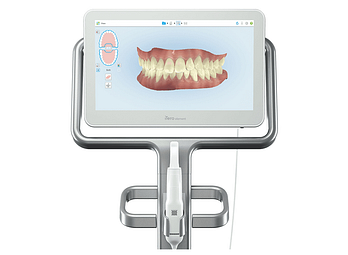
iTero Element 2
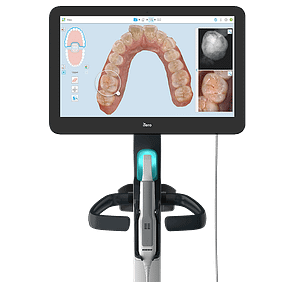
iTero Element 5D Plus
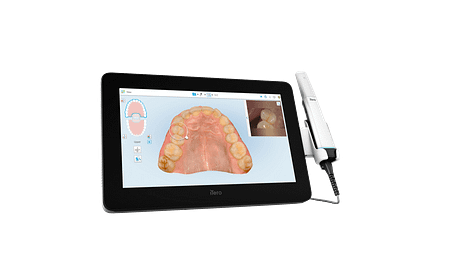
iTero Lumina
iTero and Invisalign
Align Technology acquired iTero in 2011, solidifying its position in the digital dentistry market. This acquisition allowed for seamless integration between iTero scanners and Align's Invisalign clear aligner system, creating a powerful ecosystem for orthodontic and restorative treatments.
This connection between Invisalign and iTero has been one of the main driving forces behind the success of the iTero scanners. In fact, if you want to send scans to Invisalign, you are only allowed to use iTero Scanners or 3Shape TRIOS 3 (outside of USA, Japan and China). No other scanner is accepted.
As the company tries to shake off this association as the 'invisalign scanner' and be seen as a full-fledged, general-purpose IOS for everything, it has recently launched iTero Design Suite - thanks to Align also owning exocad.
What is iTero Design Suite?
The iTero Design Suite is, in essence, a cloud-based adaptation of exocad. Although Align Technology avoids labeling it this way, preferring the term “powered by exocad,” the interface clearly draws from exocad’s ChairsideCAD. Dental professionals familiar with exocad will immediately recognize the familiar workflows and design tools, now made more accessible through a simplified and streamlined interface.
This solution integrates directly with iTero intraoral scanners, creating a connected workflow for in-house design and 3D printing of models, appliances, and restorations. While the software is downloaded and installed locally, the design process itself takes place in the cloud. It's not a browser-based platform like Dentsply Sirona’s DS Core, which raises the question of why Align didn’t take the fully web-based route - but the hybrid approach still works smoothly in practice.
Once installed, users can send scan data from the myitero.com portal directly to the Design Suite, where exocad's design environment is launched in a cloud session. At present, the system supports model design, splints, single-unit crowns, inlays, onlays, veneers and bridges. Most recently they have also added mockups.
Given the underlying CAD engine and cloud infrastructure, I am curious what the company also adds in the future.
Key Features and Workflow of iTero Design Suite
The iTero Design Suite represents a significant development in cloud-connected CAD software for dentistry. While not the first cloud-based dental CAD solution, it offers integrated workflow capabilities that connect iTero scanning directly with design and manufacturing processes including multiple CAM software and the Sprintray Cloud for 3D printing.
After the purchase of exocad by Align, we were all waiting on how they would bring this to iTero. Well we have the answer now.
Let's dive into the key features and workflow that make this suite a potential game-changer for dental practices:
Integrated Workflow
The iTero Design Suite offers a seamlessly integrated workflow that connects directly with existing iTero scanners, allowing for a smooth transition from scanning to design.
This integration provides several advantages:
- Direct Access - users can access their scans anywhere directly from the MyiTero portal after completing a scan.
- Streamlined Process - the transition from scanning to design is smoother than ever before for iTero, eliminating the need to export and import files between different software platforms.
- Cloud-based - you do not need a powerful computer to run iTero Design Suite. You can also have the iTero Design Suite computer separate from your scanning computer, which will help you free it up for the rest of the clinic to use to scan while you design.
The workflow itself from Scan-Design-Print especially works very well when combined with a Midas (which I have been testing). I am enjoying it as much as the CEREC workflow, although it does require logging into the myitero.com portal.
exocad-Powered Design Tools
The exocad CAD software is at the heart of the iTero Design Suite. This is essentially ChairsideCAD by exocad repackaged in a way. This is not the fully-fledged exocad DentalCAD that labs use.
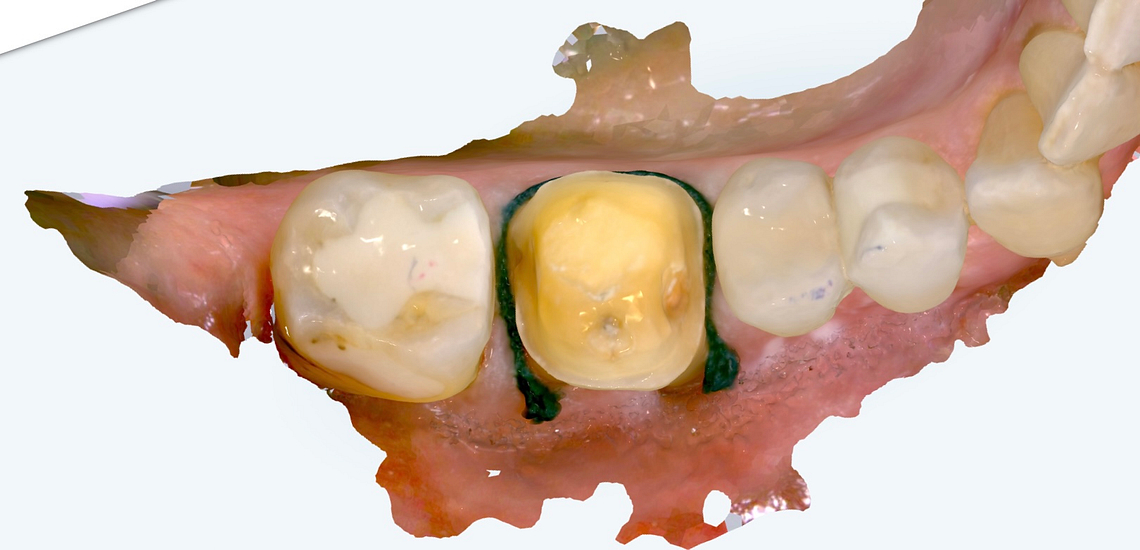
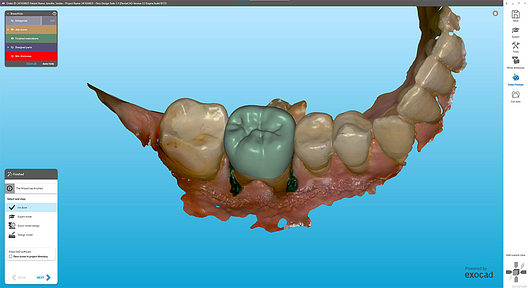
One interesting thing that I feel was a missed opportunity was to reimagine the exocad interface, making it more user-friendly and accessible to dental professionals who may not have extensive CAD experience. Even some of the terminology could have been changed. This looks and feels like exocad.
Current Applications
Model Builder
The software provides flexibility for digital model creation, with options for both solid or hollow models for 3D printing. Many options exist, such as automatic calculation of removable dies and drain holes, and the ability to add custom text for model identification. Similar to Medit Model Builder - although I would call this the most user-friendly model builder on the entire market. Regardless, it is nice that iTero now has a model builder finally via the Design Suite.
Single Crowns
The iTero Design Suite can be used to design crowns. It includes all the standard exocad features, including automatic margin line detection with the option for manual refinement, insertion axis visualization and adjustment tools, and a library of tooth shapes with customization options.
Inlays, Onlays and Veneers
In addition to single crowns, the software supports the design of inlays, onlays and veneers. Users can leverage the same exocad-based tools for margin refinement, material selection, and anatomical customization to produce precise and esthetic restorations.
Bridges
The Design Suite enables multi-unit bridge design, including automatic pontic generation and anatomical adjustments. Users can customize connector dimensions and design for both functional and esthetic needs.
Smile Mockups
The suite also supports esthetic mockup creation, enabling clinicians to visualize and communicate proposed treatment outcomes. These mockups can be used for patient motivation, case acceptance, or as a guide for provisional restorations.
Bite Splints
The iTero Design Suite offers CAD for creating bite splints. It begins with automated teeth segmentation. Users can customize splint thickness and extension, allowing for patient-specific adjustments.
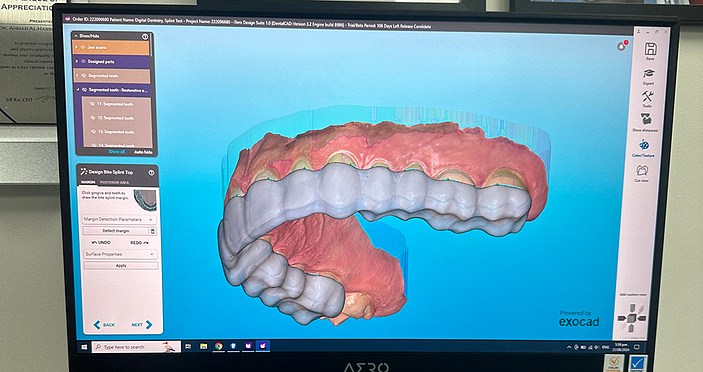
3D Printer and Mill Integration
A key feature of the Design Suite is its direct integration with various mills and 3D printer brands, including Formlabs, SprintRay, Asiga, 3D Systems, Desktop Health, and Phrozen. This effectively closes the entire workflow from scan and design to manufacture.
Currently, iTero Design Suite supports integration with 22 3D printers, making it the one of the most integrated solution on the market. Supported printer brands include: 3D Systems NextDent, ASIGA, DEKEMA, Desktop Health, Formlabs GmbH, Phrozen 3D, SprintRay, Way2Production GmbH, Kulzer Cara, Ackuretta, WhipMix, DWS, HeyGears, Microlay, MiiCraft, Nexa3D, Planmeca, Prusa Medical, Rapidshape, UNIZ, Shining 3D, and Mogassam. With the release of version 1.1, the Design Suite also introduces integration with milling machines. It supports all milling units compatible with Millbox/CIM System, including Imes-Icore, Zenotec, Wieland, DG Shape, and Up3D.
These integrations aim to streamline the production process by potentially eliminating the need for exporting and importing finished designs. For example, once you finish designing a splint. You can click the Sprintray button, and it will open up the Sprintray software, automatically inputting patient details, and have the design nested and ready for printing.
Integrations are everything for digital dentistry companies going forward.
Integration with Align Ecosystem
The iTero Design Suite doesn't exist in isolation – it's part of a broader ecosystem of Align Technology products. These include Invisalign Integration and Align Oral Health Suite.
The Align Oral Health Suite is their communication portal within the iTero Software which allows for a comprehensive examination appointment, from initial patient scans and diagnostics, to alignmer simulation and comparing scans overtime. This diagnostic tool set features things like caries detection and wear monitoring.
What iTero are building is becoming quite interesting to be honest. As someone who has been one of the largest critics, I have to say it is quite a well-rounded software.
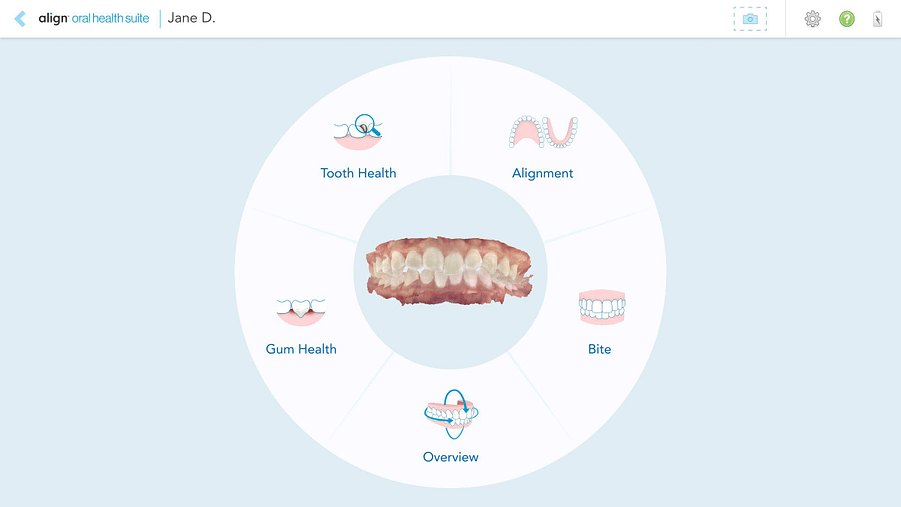
Another feature is the intraoral camera and NIRI images that can be integrated into the Design Suite. A unique iTero 5D / Lumina feature. What iTero has been building seems quite substantial.
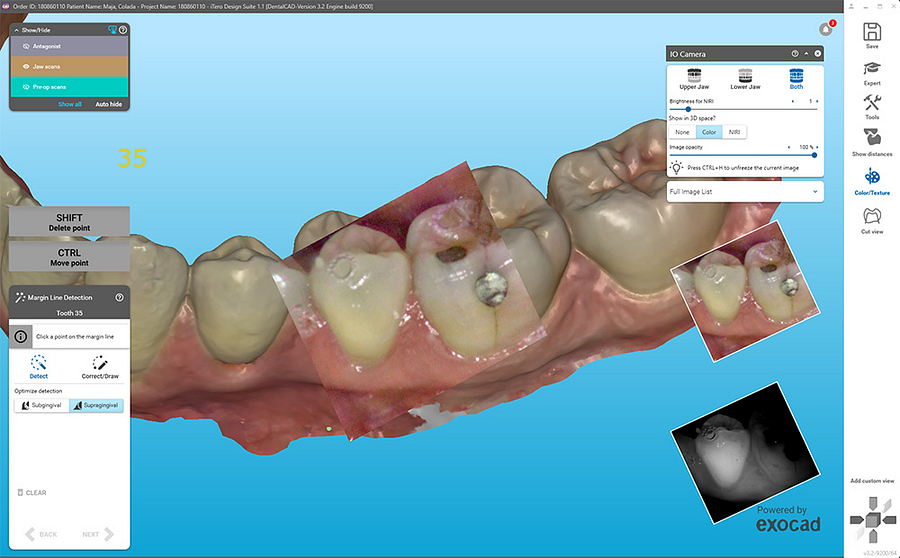
Future Developments
I would not be surprised to see regular updates and expansions to the iTero Design Suite. When I first tried it around a year ago, it was very laggy and I was not particularly impressed as although the concept was there, it was hard to use. Now, it is a totally different product. I find myself using Design Suite more than exocad chairside for simple cases. It just works.
Potential areas for future development could include:
- Integration with AI for automated design suggestions
- Expanded restorative options
Considerations and Potential Challenges
The iTero Design Suite marks a significant evolution for iTero, finally bringing CAD to iTero.
By combining their new Lumina scanner with the powerful design capabilities of exocad, Align Technology has created a potentially game-changing system for dental practices. And something that may be finally worth the prices Align Technology commands for their scanners.
While iTero Design Suite offers numerous benefits, it's important to consider several factors:
- Learning Curve: Although designed to be user-friendly, there will still be a learning curve, especially for those new to CAD design. Exocad is not the easiest CAD software.
- Initial Investment: The software is available on all iTero scanner models that include an Orthodontics/Resto Comprehensive Service Plan, which comes at no additional cost for the first 12 months as part of the scanner purchase. Importantly, access to the iTero Design Suite is bundled within this service plan and remains available at no extra charge as long as the plan is active.
If the service plan is discontinued by the user after the initial 12-month term, access to the Design Suite is also lost and cannot be purchased separately, it is only available as part of the full-service plan. Practices should factor in these ongoing service plan costs when evaluating the long-term value of the scanner. That said, it's a very interesting move to see iTero include the Design Suite within the existing subscription, significantly enhancing the scanner’s overall value. - 3D Printer / Mill Requirements: To fully leverage the Design Suite, practices will need compatible 3D printers or milling machines. This may require additional investment for some practices. There is no point designing without an output.
- Regulatory Compliance: As with any medical device manufacturing, ensuring compliance with local regulations regarding in-house production of dental devices is essential.
Conclusion
The iTero Design Suite is a major milestone for Align Technology and a clear signal of where the industry is heading.
By combining the performance of the iTero Lumina scanner with exocad’s design power, Align has created a cloud-connected solution that finally brings true CAD capabilities to the iTero ecosystem.
What was once a clunky, laggy beta has transformed into a practical, easy-to-use platform that to be honest, the entire industry should take note of. This is the future of chairside workflows.
There are, of course, some considerations. Practices must account for the learning curve, subscription costs, and hardware requirements such as 3D printers or mills. But Align has taken a big step in the right direction by bundling Design Suite access into their scanner subscription, significantly increasing its value proposition.
The infrastructure is in place, and the potential is enormous. At the Institute of Digital Dentistry, we’re excited to see how this platform evolves.
I will be providing an in-depth review of the iTero Lumina soon! As always, I encourage you to approach new technology with a balance of curiosity and critical thinking. Consider how iTero Design Suite might fit into your clinical workflows, your team’s capabilities, and your patients’ needs.
Have you tried the iTero Design Suite? What are your thoughts so far? Share your experience in the comments or reach out to us directly.
The future of dentistry is digital. Stay curious. Stay informed. And keep pushing boundaries.

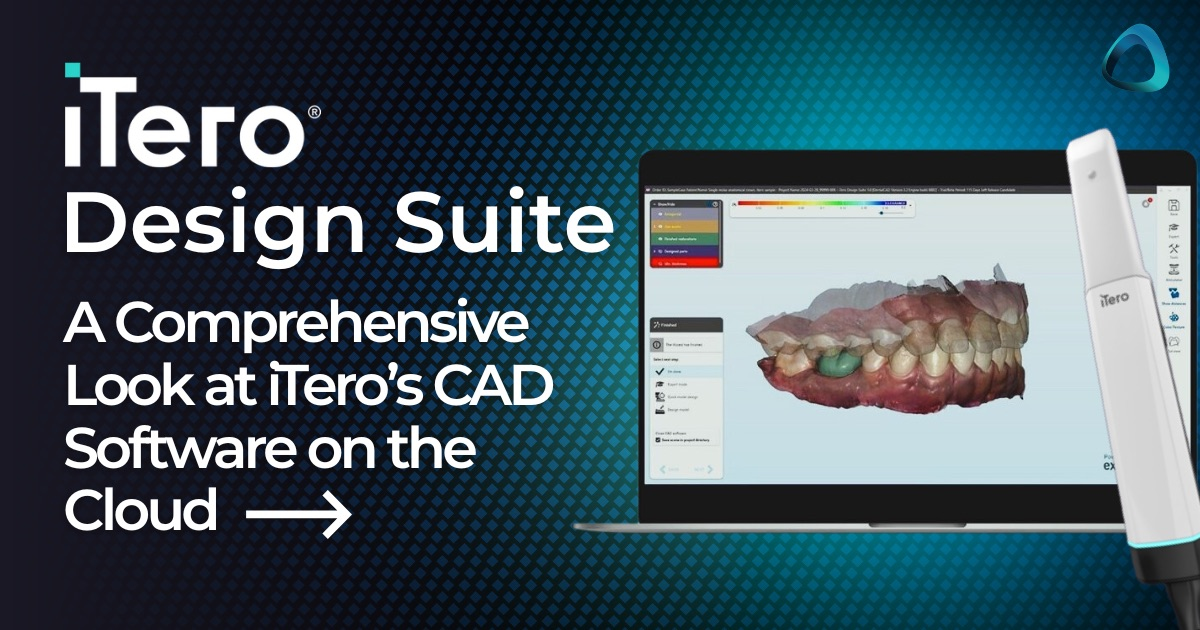
Hi, do you have a course on IDD to learn using Itero Design Suite ?
Hi Elias. We have an excellent online exocad course here – https://instituteofdigitaldentistry.com/bundles/mastering-exocad-online-course-training/
iTero Design Suite is essentially exocad, so as long as you rep sets up the integration, once you start it you can use everything you apply in the exocad training here too.